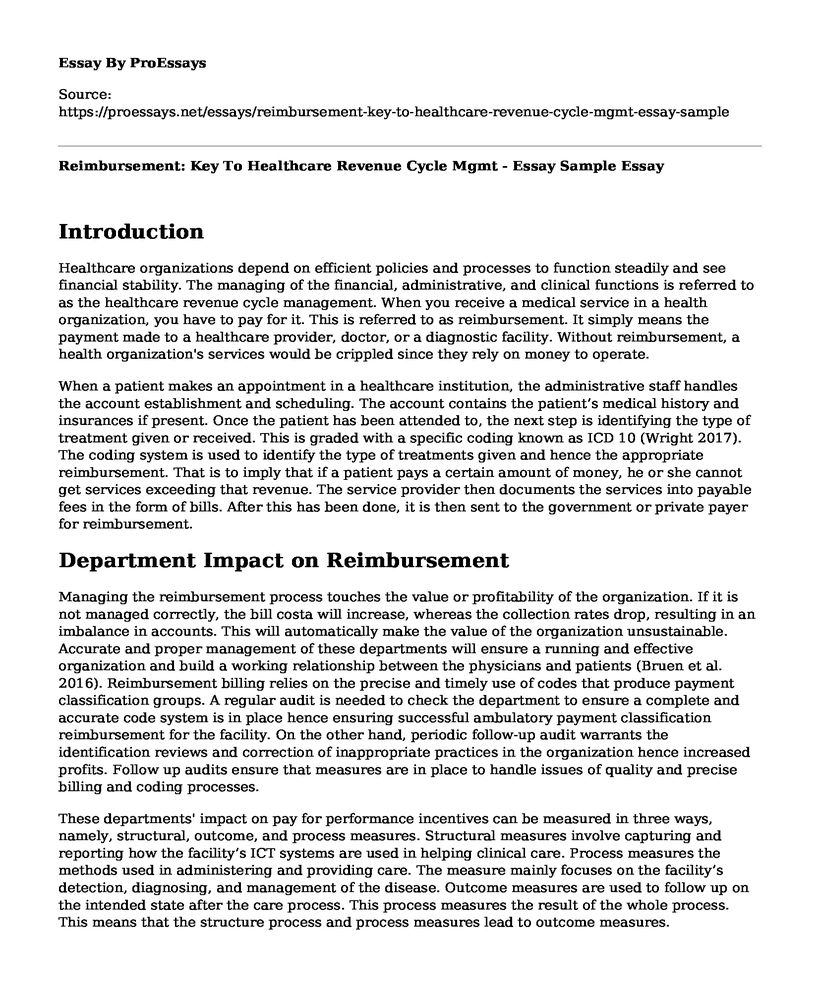Introduction
Healthcare organizations depend on efficient policies and processes to function steadily and see financial stability. The managing of the financial, administrative, and clinical functions is referred to as the healthcare revenue cycle management. When you receive a medical service in a health organization, you have to pay for it. This is referred to as reimbursement. It simply means the payment made to a healthcare provider, doctor, or a diagnostic facility. Without reimbursement, a health organization's services would be crippled since they rely on money to operate.
When a patient makes an appointment in a healthcare institution, the administrative staff handles the account establishment and scheduling. The account contains the patient’s medical history and insurances if present. Once the patient has been attended to, the next step is identifying the type of treatment given or received. This is graded with a specific coding known as ICD 10 (Wright 2017). The coding system is used to identify the type of treatments given and hence the appropriate reimbursement. That is to imply that if a patient pays a certain amount of money, he or she cannot get services exceeding that revenue. The service provider then documents the services into payable fees in the form of bills. After this has been done, it is then sent to the government or private payer for reimbursement.
Department Impact on Reimbursement
Managing the reimbursement process touches the value or profitability of the organization. If it is not managed correctly, the bill costa will increase, whereas the collection rates drop, resulting in an imbalance in accounts. This will automatically make the value of the organization unsustainable. Accurate and proper management of these departments will ensure a running and effective organization and build a working relationship between the physicians and patients (Bruen et al. 2016). Reimbursement billing relies on the precise and timely use of codes that produce payment classification groups. A regular audit is needed to check the department to ensure a complete and accurate code system is in place hence ensuring successful ambulatory payment classification reimbursement for the facility. On the other hand, periodic follow-up audit warrants the identification reviews and correction of inappropriate practices in the organization hence increased profits. Follow up audits ensure that measures are in place to handle issues of quality and precise billing and coding processes.
These departments' impact on pay for performance incentives can be measured in three ways, namely, structural, outcome, and process measures. Structural measures involve capturing and reporting how the facility’s ICT systems are used in helping clinical care. Process measures the methods used in administering and providing care. The measure mainly focuses on the facility’s detection, diagnosing, and management of the disease. Outcome measures are used to follow up on the intended state after the care process. This process measures the result of the whole process. This means that the structure process and process measures lead to outcome measures.
The front office gets the information and qualification of the patient, the back office follows and clears charging alters. The clinical office is just expected to understand waivers and assents. The administration then oversees the whole process by surveying income cycles and disintegrates patterns in relation to reimbursement. Behind it all, medical coders analyze, select, and manage patient data. A coder's work should illustrate a patient's record in full. When the payers pick up a bill and understand the patient's process, billing becomes easier and simplified.by this, the coders are expected to be thorough and evade missing codes that could, in turn, affect reimbursement or care delivery. Organizations are steadily moving to substitute models of payment that connect reimbursing to good performance. When medical coding is done accurately and correctly, it can improve health organizations' billing and performance. Enabling coders to do more than just get a claim paid should help health organizations avert denials, give clean claims and improve overall patient care at their respective organizations
References
Bruen, B. K., Docteur, E., Lopert, R., Cohen, J., DiMasi, J., Dor, A., ... & Shih, C. (2016). The impact of reimbursement policies and practices on healthcare technology innovation.
Wright, K. (2017). Revenue Cycle and Reimbursement. Health Information Management: Principles and Organization for Health Information Services.
Cite this page
Reimbursement: Key To Healthcare Revenue Cycle Mgmt - Essay Sample. (2023, Aug 28). Retrieved from https://proessays.net/essays/reimbursement-key-to-healthcare-revenue-cycle-mgmt-essay-sample
If you are the original author of this essay and no longer wish to have it published on the ProEssays website, please click below to request its removal:
- Diagnosis Adoption: Stage IV Congestive Heart Failure
- Essay Example: Accessibility Issues for Disabled Students on College Campuses in 2018
- Essay on Graduate Nursing Practice
- Employees and Organizational Change Paper Example
- Essay Example on Secure Communication, Boost Stock and Quality Staff
- Essay Example on Price Variations of Commodities: Challenges to Equilibrium
- Nursing Self Reflection - Essay Sample







